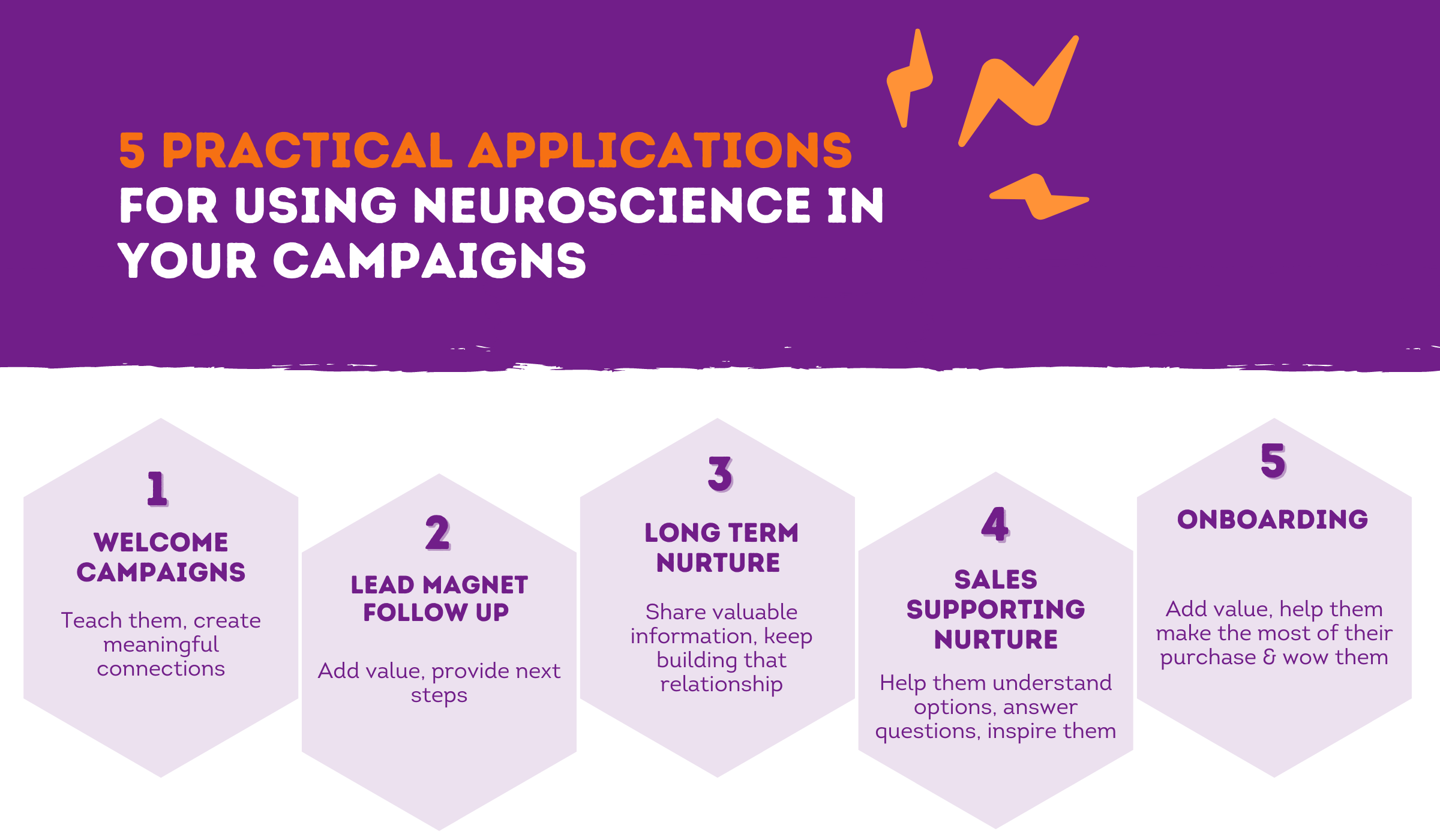

How to make the purchase formula work for you

In our previous post, we chatted about the brain works when it makes a purchase decision (check it out here), but how do you take all that neuroscience and *actually* use it? We mentioned how nurture plays a significant role in helping the brain decide to buy, but how can you make that happen for you?
We’re not about vague theories that have no real application! So let’s take a look at some practical applications for using these insights as we walk through 5 ways to pack a punch with the purchase formula in your very own campaigns. 
1. Welcome campaigns
Never underestimate the power of a really good welcome campaign! The very first time a new contact joins your list, you should roll out the red carpet. When you provide a fantastic welcome and wow campaign you’re able to provide the brain with context as to why you do what you do, how you do it, and what that means for them.
Welcome campaigns mean you have the opportunity to align your audience with what drives and motivates you, and that makes for a powerful connection when it’s aligned to the things they care about. The story you tell in your welcome campaign sets the tone for your relationship, it’s a foundation for all your communications going forward.
A good welcome campaign will always come back to the audience, teaching them about who you are through helping them, and giving them far deeper and more meaningful connections with you as a brand.
The cognitive takeaway for your welcome campaign:
Level up your welcome campaign by showing them how you help them achieve their goals. Always look at the content and ask: “How is this meaningful to my audience? What value does this bring to them?” Focus on providing context that aligns with the things they care about so that you increase their reward activation and build a relationship.
2. Lead magnet follow-up
When a contact signs up for an ebook, resource, newsletter, or any of your other fabulous lead magnets the power of nurture comes to play! Lead magnet follow-up gives you the perfect opportunity to add value – and value add is precisely what we’re after when we’re working to keep the brain happy.
Lead magnet sign-ups tell us quite a bit about our audience, we learn things like:
- What’s a problem for them right now
- What they are interested in
- Where they are in their buying journey
- How ready they are to purchase
This information is vital for creating more targeted follow-up. Fantastic nurture-based follow-up uses this to create a series of emails and actions that help us add value relative to where they are, and provide the appropriate next steps for them in their journey.
The cognitive takeaway for your lead magnet follow-up campaign:
The easiest way to add value is to encourage consumption. Break up your lead magnet into its most vital components, split that over a series of emails, and add value over and above what you have given them. Educate your audience and focus on getting them to the next step in their buyer’s journey. This repetition and leveling up of the information you’ve already given them means the information will be more easily recalled in memory and is therefore labeled by the brain as more valuable.
3. Long-term nurture
What do you do when your leads and customers are done with their existing campaigns? Do they fall into the void of nothingness – never to hear from you again? Perhaps a newsletter every now and then? A sporadic sale campaign?

Nurture shouldn’t stop just because your campaigns aren’t running right now. Nurture is forever.
Your long-term nurture is precisely what it says on the tin – nurture that runs for a very long time. This type of nurture is the type of activity that can boost your conversions in the most impactful way because it raises the baseline engagement, helps you learn more about your audience, and is consistent enough that the brain knows how to deal with it.
What’s that? Did you say: “Oh no… Something else I have to create a tonne of content for” Worry not! If you’re already creating content as part of your SEO/ inbound marketing strategy, or have existing blog posts and resources, you can use what you have in place. The important thing is to provide useful content over a longer period of time.
We like to set up long-term nurture campaigns as a catch-all, the place everyone ends up in. These get triggered to go out once a week or every two weeks as a minimum. Giving you ample opportunities to build a relationship and show up with valuable information that your audience needs.
This strategy is what increased the conversion rate for one of our clients by 351%. The consistent value add gives the brain time to build a healthy and positive reward activation for your brand.
The cognitive takeaway for your long-term nurture campaign:
Find out what your audience finds valuable, and drip educational content to them over a long period of time. Value is key to increasing the reward activation, and long-term nurture is one of the easiest and best ways to get higher activation in the brain. Combine this with your existing content strategy to make sure you’re not adding too much work to your own plate! Bonus points if you track what they engage with, allowing you to personalize their journey later on down the line.
4. Sales-supporting nurture
Sales campaigns are the traditional spot for nurturing for most companies – but we can do better! If you have a longer, more protracted sales cycle, you can use some strategic content to help your consumer understand their options and help them make the best decision possible.
Sales-supporting nurture is content that helps the consumer understand their options, answers their questions, and gets them ready to have a far more meaningful conversion with sales (if you don’t have a sales team, sales supporting nurture will be the best salesperson you’ve never had).
By sending this helpful and valuable content alongside the sales process, you’re ensuring your prospect not only has the information they need to make a purchase decision but also is motivated and inspired. Your prospects build a stronger relationship with you, sales have clearer and more qualified conversations, and you get to celebrate higher conversion rates together.
The cognitive takeaway for your sales-supporting nurture campaign:
The brain needs context and understanding to make a positive purchase decision. Your sales-supporting nurture can provide this by partnering with sales to answer questions and prepare your prospects in a way that makes them more qualified and nabs you those higher conversion rates. Work with your sales team to identify what prospects really want to know at the end of the funnel, and create drip campaigns that provide this high-value information.
5. Onboarding
Is your job done when you’ve got the sale? Absolutely not! Profits often come from customer lifetime value: the art of getting a customer to make repeat purchases and stick around for long periods of time. To do that you need to make sure they’re happy right from the start!
Onboarding is a fantastic way to get every customer and client to feel confident about their purchase, use it, and start to enjoy the process of your products and services. Simply by having this process feel positive – you can increase the reward activation in the brain – and that means more sales for you!
Build a strong relationship with new customers by rewarding their purchase with a beautifully laid out and thoughtful onboarding campaign that shows them how to get the most out of their products and services.
The cognitive takeaway for your onboarding campaign:
Reward activation is all about that value add, and one of the best ways to add value is by delighting your customer, making them feel cared for and appreciated. The second moment of truth is the point at which your customer or client uses their product and starts to develop an opinion on it, help them enjoy it by wowing them. Show them how to best use their purchase, get them to use it, ask them how they feel about it – get them involved and show you care!
Wrap-up

There we have it! That’s 5 ways to increase reward activation in the brain. Each practical application always comes back to the core of:
- Add value
- Nurture through education
Email is a fantastic tool for this, but don’t forget that you can spice up this strategy with omnichannel delivery. Your core focus should simply be on the best way for you to get that value to your end customers.
Need some examples to see this in action? Stay tuned for next week where we’ll be taking a look at some campaigns that have used this strategy fantastically!
Contents
Kenda Macdonald
Stay on top
Get the latest and greatest marketing insight delivered to you weekly
Your email address will be handled in accordance with our Privacy Policy. We gather data around email opens & clicks using standard technologies including clear gifs to help us monitor and improve our newsletter.

